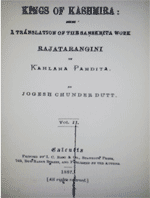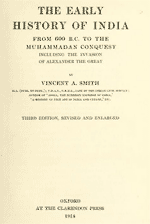
Jogesh Chunder Dutt, Kings of Kashmira: Being a translation of the Sanskrita work Rajataranggini (London: Trubner & Co, 1879)
The Rajataranggini, a twelfth century book, which explains the history of Kashmir, has many important references about the Khas people. Written in Sanskrit by a Kashmiri Brahman named Pandita Kahlana, the book describes the history of Kashmir and its monarchs in a way that nobody had ever worked before his time.
The author, who seems to be a court staff at the royal palace, chronicles in the book the rulers of the Kashmir valley from earliest times, from the epic period of the Mahabharata to the reign of King Sangrama Deva (c.1006 CE), before the start of the Muslim era in the sub-continent. Kahlana draws a long list of kings which dates back to the 19th century BCE. His list is comprehensive, although there are many details in the book, which give the impression that the book is not just historical, as he has claimed, but it also ventilates his personal point of view and prevailing legends. With 7826 verses, which are divided into eight folios, the book begins with the legendary reign of King Gonarda. He is described as contemporary toYudhisthira of the Mahābhārata epic. The real history, however, begins from the period of the Mauryas – the Iron Age historical power in this region.
PanditaKahlana was the son of Champakprabhu. He was surprisingly well read and had good understanding of the Kashmira valley, and surrounding hills and mountains. His father served as a Minister of Kashmira. The book, in its make up looks likeGopalarajavanshavali of Nepal, or similar chronicles of medieval Europe and of the Muhammadan East.
Jogesh Chunder Dutt, who translated the Rajataranggini in English for the first time, also contributed a preface to the book, explaining its overall context. In this preface, referring to the Himalayan region from Kashmir to Nepal, and the overall significance of the book, Dutt points out: “[W]ithin this vast continent lived from the remotest antiquity a portion of the Aryan race who developed among themselves a degree of civilization unattained by any other nature of antiquity. This people, though originating from the same stock, speaking the dialectics of the same language, and following the dialectics of the same religion, had only divided themselves into different tribes according to the physical nature of the portion of the country which they each came to occupy. The Kashmirians and the Nepalese who in-habited the mountainous region of the Himalayas were different from those who dwell in the valleys of the Indus or the Ganges or occupied the deserts of Rajputana or the tableland of Maharashtra. Nor did the division cease there.” Referring to Houen Sang, the Chinese pilgrim, who visited this region in the 7th century, Dutta speaks of 138 such principalities, of which 110 were personally visited by Houen Sang. The internal diversity between them was therefore bound to exist.
The Rajataranggini mentions about the Khas people in different context. Although no specific chapter is devoted to them in the book, they find space here and there. From the details provided, it is clear that Kashmir and the adjoining principalities had significant presence of Khas communities. They came from different realms and wielded different social identity, wealth and power. They had their own kingdoms (or lorddoms) in several places. They differed vastly with the Kashmiri kings and their people. It is clear that the wordKashmira itself seems to be related with the Khas [Khas-mira] people; however, Kahlana does not explain this connection. It is very likely that Khasas came to be settled there long before others came to join. This seems to be the basis of animosity that Khasas had against others including the Kashmiri kings. This is probably the reason Khasas posed challenge in the existing power relationship.
According to Kahlana, King Jayapira, who was a great patron of learning, ascended the throne of Kashmir in 745. He used to invite men of genius to his court. He also employed learned men in collecting the work of Patanjali, Katyana and Panini – the three ancient scholars before this time. He was brave and engaged in expansion of the kingdom continuously. Once when he set out for conquest of the Kingdom of Bhimsena, which appears to be a Khas kingdom, and again in Nepal, “he was beaten and imprisoned, but on both occasions he managed to escape and to triumph, over his enemies in the end.” Kahlana also writes that in early 10th century, in the short reign of Kashmiri King Gopalavarma, Minister Prabhakara (who was a favorite of the queen mother Sugandha), defeated the reigning Shahi, another Khas dynasty that existed at that time, because he had disobeyed his orders to build a town in Shahirajya. This seems to have been some petty dependent or tributary king. A place called Dinnagrania is also said to have been inhabited by the Khasas. Kahlana also mentions about how the Kashmiri King tried to conquest King Aramuri [Arimundi] of Nepal, and was imprisoned in deplorable condition at the bank of Kali-gandaki river. King Aramuri has been referred to by Kahlana as “the learned and wily king of Nepal” who wished to engage himself in war with Jayapira.
Further, another King, Sussala, has been mentioned in another context. His armies are said to have entered a town of the Khashas. Sussala is credited for “attacking and chastising” them. He is said to have fortunately returned to Lohara, his place, in time, passing through roads difficult to traverse on account of fall of snow. He faced death at every step but his period of life was not yet ended, and he lived and thought of the means of obtainingKashmira.
Even though the Khashas wielded powers, they are not named with respect anywhere in Kahlana’s book. In one place Kahlana writes: “The powerful lord of Khasha had, through indulgence in wine and in gross vices, become an object of pity, like a vulgar beast, and lost his senses. His courtiers acted properly or improperly without any restriction.” At another place, Kahlana states how the Khashas were difficult to be managed with, and how they were manipulated by interlocutors by making them drink. They were made to drink, and the fact was intimated to Bhoja, the puppet of a local king. The king was informed without reserve, by Bhoja, of what was ‘going on, “but that wise sovereign whose senses were not bewildered, felt doubtful about the conclusion of the peace and uncertain about the success of the negotiation without making an impression on the heart of the enemy.” The King then sent queen Samanyato Taramulaka for further negotiation. Still in another reference, Damshaka, a lord of Kampana, is said to have incurred the king’s anger because ‘he was enjoying prosperity; he fled to “Vishalaya and was kitted by the Khashas.” Another lord, Udaya, crossed over theSankata in the month of Vaishakha and fought a battle with Bhikshu who was attended by the Khasha. All these accounts give a poor impression of the Khas people.
As it appears, the country of the Khasas is said to have also comprised the valleys lying to the west of Pira-Pantsala-range between the middle course of Vitasta river in the west, which is believed to be one of the seven Sapta Sindhu rivers mentioned so many times in the Rigveda (now called Jhelum) and the Kastavata in the east. The country of Rajauri, which was ruled by the Kambojas in epic times, was ruled by the Khasas in the later times.
The Rajataranggini is still a valuable work. The scholars writing on the Khasas may find it extremely important even now.





